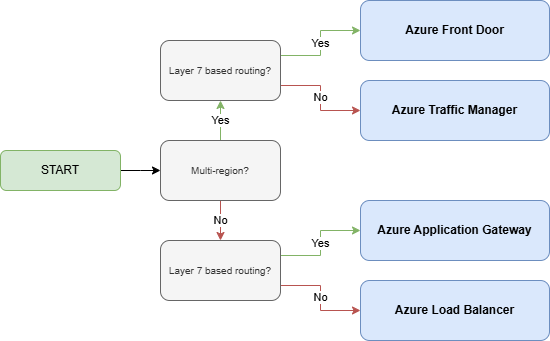Azure Decision Tree: App Traffic Routing
An Azure Decision Tree provides a flowchart to evaluate different options based on specific requirements.
less than a minute
Azure Services
Azure Front Door
- Layer 7 Routing: Routes HTTP/HTTPS traffic globally using:
- Latency-Based: Directs traffic to the fastest backend for users.
- Path-Based: Routes requests to specific backends based on the URL path.
- Protocol-Based: Manages traffic for HTTP/HTTPS protocols.
- WAF Rules: Includes routing decisions influenced by security policies.
Azure Traffic Manager
- DNS-Based Routing: Routes traffic globally at the DNS level using methods like:
- Priority: Routes traffic to the primary endpoint unless it’s unhealthy.
- Performance: Directs users to the closest endpoint with the lowest latency.
- Geographic: Routes traffic based on the user’s location.
- Weighted: Allocates traffic to endpoints based on assigned weights.
Azure Application Gateway
- Layer 7 Routing: Manages HTTP/HTTPS traffic regionally using:
- URL-Based: Routes traffic based on specific URL paths.
- Host-Based: Directs traffic based on the host header in HTTP requests.
- Cookie Affinity: Routes requests from the same user to the same backend.
- SSL Offloading: Handles encryption/decryption to reduce server load.
Azure Load Balancer
- Layer 4 Routing: Distributes TCP/UDP traffic within a region using:
- Hash-Based: Balances traffic across backends based on a hashing algorithm.
- Health Probes: Directs traffic only to healthy backend instances.
Decision Tree

Feedback
Was this page helpful?
Glad to hear it!
Sorry to hear that.